This is a Certo Super Dollina II, a 35mm rangefinder camera made by Certo Camera Work GMBH Dresden starting in 1950. The Super Dollina II was an update to the pre-war Super Dollina which made it’s debut in 1938. Featuring a coupled split image rangefinder and a unique folding chassis with top plate focus and shutter release, the Super Dollina II was a less expensive alternative to cameras like the Kodak Retina II. It was exported to western countries under the name Certo Super 35. The Super Dollina II was in production for a very long time and remained their top of the line model as the company would produce increasingly less expensive and basic cameras.
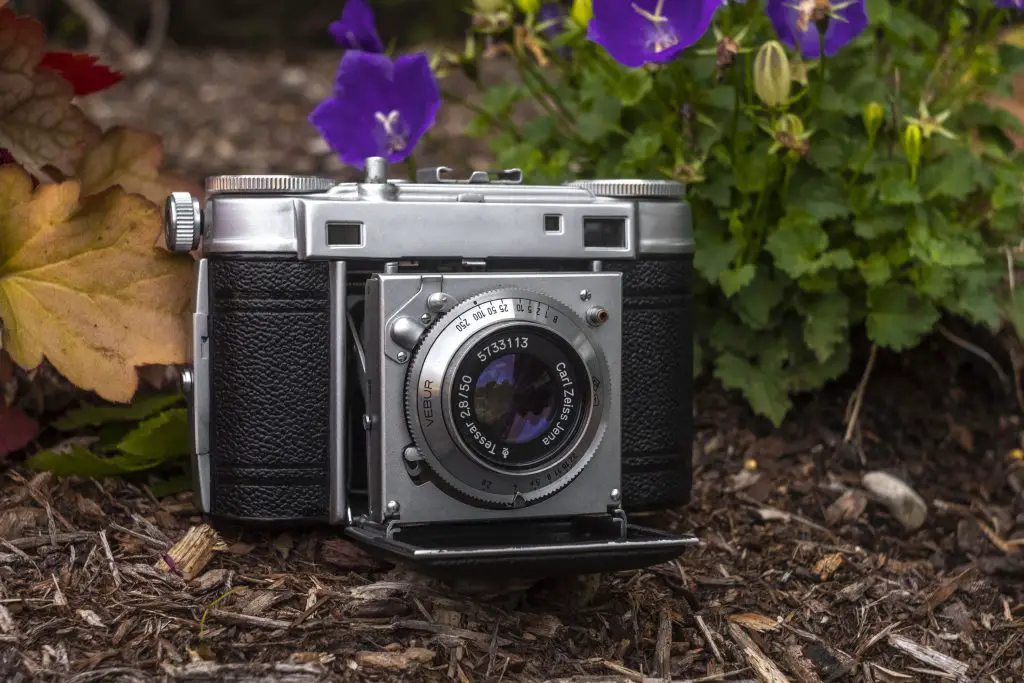 Film Type: 135 (35mm)
Film Type: 135 (35mm)
Lens: 50mm f/2.8 Carl Zeiss Jena Tessar coated 4-elements
Focus: 4 feet to Infinity
Viewfinder: Separate Split Image Coupled Rangefinder
Shutter: Vebur Leaf
Speeds: B, 1 – 1/250 seconds
Exposure Meter: None
Battery: None
Flash Mount: Coldshoe with Flashbulb Sync
Weight: 471 grams
Manual: https://www.cameramanuals.org/pdf_files/dollian_super_ii.pdf
How these ratings work |
The Certo Super Dollina II is what might have happened had the Retina been built in East Germany. The camera is compact, solidly built, and came with a good lens and a decent shutter, but sacrifices with a pre-war viewfinder and rangefinder, along with a strange focusing system means that it could never compete with an actual West German Retina. Still, the Dollina is just different enough and with it’s Tessar lens, can still make as good of images as the best of them. If you’re bored of the same old folding 35mm cameras, this one’s worth a look at. | ||||||
| Images | Handling | Features | Viewfinder | Feel & Beauty | History | Age | |
| 2 | 1 | 1 | 0 | 2 | 0 | 30% | |
| Bonus | none | ||||||
| Final Score | 7.8 | ||||||
History
When you think of early makers of 35mm cameras, Kodak, Leitz, and Zeiss-Ikon often come to mind as their respective Retina, Leica, and Contax cameras were very popular and were produced for a long time. What many people don’t know is that there was a fourth company who jumped on the 35mm bandwagon early on called Certo.
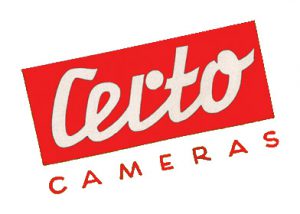 Certo Kamera Werke Dresden was founded in 1902 by Alfred Lippert and Karl Peppel who were both German engineers. They adopted the name Certo which is Latin for “safe and reliable”, and released their first camera, the Certo No. 0, in 1905.
Certo Kamera Werke Dresden was founded in 1902 by Alfred Lippert and Karl Peppel who were both German engineers. They adopted the name Certo which is Latin for “safe and reliable”, and released their first camera, the Certo No. 0, in 1905.
Throughout the early part of the 20th century, Certo released a variety of mid-priced folding cameras. Certo cameras were neither cheap nor top of the line, but they were respected in their day. Their products were comparable to Welta and Balda who were two other German camera manufacturers of the time. The company experienced it’s best success in the late 1920s and 30s before World War II.
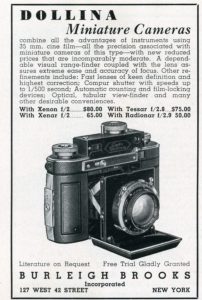
Within a year of the Kodak Retina’s introduction, Certo released the Dollina which used Kodak’s new 135 format 35mm film. The price of a Dollina was somewhere around $50 USD which translates to $940 today. Although this was quite a bit of money for the time, the price was half of a comparable Kodak Retina, and considerably cheaper than top of the line Leica and Contax cameras which sold for over $250.
There were a lot of similarities between the original Retina and the original Dollina. Both were compact sized German built folding cameras. Both had lenses with excellent optics and Compur shutters capable of 1/300 and eventually 1/500 seconds. Also, both cameras originally were scale focus, with a rangefinder model released a short time later.
Only one year after it’s debut, the Dollina II was released which featured a coupled split-window rangefinder. The rangefinder on the Dollina II was added to the top of the original model (now called the Dollina I). Because a Dollina II is essentially a modified Dollina I, the scale focus viewfinder from the original camera remains on the new model. To focus and compose a shot, you have to look through two different windows. The rangefinder window is on the rangefinder itself, above the top plate of the camera. Once the image is in focus, you’d move your eye to the other window which was on the main body of the camera, for composing your shot.
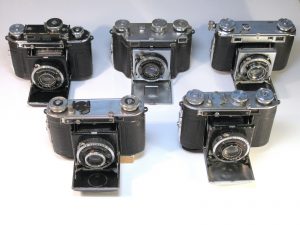
In 1938, both the Dollina I and II were replaced by the Dollina 0 and III. The Dollina 0 was a lower cost model with entry level lenses and no rangefinder. It physically differs from the Dollina I in that it omits the focusing knob on top of the camera. Focusing was done on the lens itself. The Dollina III had a completely redesigned body which was much larger than the previous models, and it incorporated the rangefinder inside of the camera. It was only available for one year only, and is the rarest of the pre-war Dollinas, and as such are very hard to find today. When one does show up, they fetch significantly higher prices, especially if they are in good working condition.
In 1939, another model called the Super Dollina was released, which like the Dollina III had an integrated rangefinder in the main body of the camera, but was much more compact. I can’t find any information about this, but I would guess that the Dollina III was not popular because of it’s bulbous shape and size. The Super Dollina was only available in a chrome finish, unlike all previous models which had bodies which were mostly black.

After the war, the Certo factory began making cigarette wrapping machines. One site says that Certo continued making Super Dollinas in secret, but then it also says that they made them for the Soviet Union as reparations. I can’t conclusively say whether or not the cameras were made alongside of the cigarette wrappers, or after.
In 1950 Certo would re-release the pre-war Super Dollina with mostly cosmetic changes as the Super Dollina II. This new model featured thinner film advance and rewind knobs, and was available with a wider range of shutters and lenses. Various models have been found with a Schneider Xenar f2.8 lens, Zeiss Tessar f2.8, Tessar f3.5, Heligon f2 or a Trioplan f2.8.
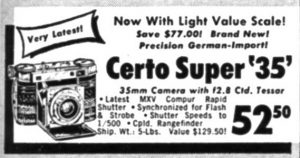
At some point during the 1950s, the Super Dollina II was exported to the United States as the Certo Super 35, and in 1956 had a retail price of $52.50 which when adjusted for inflation compares to just over $500 today. It seemed to be a popular model, being in production through the end of the 1950s, but when it ended production is not clear.
Many sites on the web say that the Super Dollina II stayed in production until the early 1970s, but I have a hard time believing that. For starters, in 1953 Certo would, like most Dresden area camera makers, be merged into what would become VEB Pentacon. Pentacon was a state owned entity controlled entirely by the East German Soviet government. By the early 1960s, Pentacon’s signature camera would become the Praktica with a few experimental models like the Pentina and Prakti being released at the same time. Pentacon’s desire was to manufacture a great number of cameras quickly and cheaply, and it is highly unlikely that a pre-war folding bellows camera like the Super Dollina II would still be in production then, let alone for another decade. Furthermore, I’ve never seen any catalog, advertisement, or even so much as a mention of this model being sold past the late 1950s, so I have to believe that’s around the time it went out of production.
 Pentacon would continue to use the Certo name in a line of very cheap plastic cameras throughout the 1970s, but would discontinue use of the name in 1982. The last known Certo produced camera was the last generation of the Exa 1b and 1c SLR which was made in the Certo factory.
Pentacon would continue to use the Certo name in a line of very cheap plastic cameras throughout the 1970s, but would discontinue use of the name in 1982. The last known Certo produced camera was the last generation of the Exa 1b and 1c SLR which was made in the Certo factory.
Today, the Certo Super Dollina II is one of many lesser known East German cameras that are plentiful but not in high demand. Sure, they’re pretty and capable of making great images, but time has largely passed by this model, only known by a small number of collectors. From my experience, they’re not that easy to find in the US but if you’re in Europe, it might be a littler easier to locate one. If you do happen to stumble upon one, it’s worth considering though as it’s a nice camera from a forgotten company.
Repairs
This Certo Super Dollina II came to me in mostly good working order with the exception that half of the split image rangefinder was missing. Thinking that perhaps a rangefinder mirror had fallen off, I removed the top plate in an effort to glue it back on only to reveal that the mirror was there, but had completely desilvered. I’ve seen some seriously degraded camera mirrors before, but never one that had lost it’s entire coating. It’s almost like someone purposely opened this camera and rubbed it off to disable the rangefinder. Seeing that there was no easy fix, I just put the camera back together and used it as a scale focus camera.
Since I didn’t actually repair anything on the camera, I won’t go into too much detail, but here are three pictures I took with the top plate off in case this helps anyone in their attempts. Removing the top plate was very easy as you just need to remove the rewind knob and all visible screws. I drew a yellow arrow next to the mirror that had desilvered on mine.
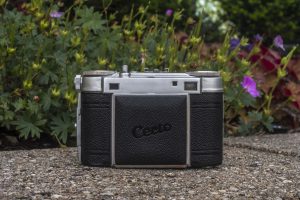
My Thoughts
I believe that when Certo first made the Dollina in 1935, their intent was to compete with the Kodak Retina, and for a while, they probably did. Both were high quality German cameras featuring a compact folding body with a good selection of shutters and lenses. As it did for a number of companies, World War II not only negatively affected Certo, but the entire Dresden camera industry.
By the time this Super Dollina II was released in 1950, it was likely seen as a ‘last hurrah’ for a company that very few people outside of Germany had heard of. The ad from 1956 in the section above lists the export Certo Super 35 for $52.50 which is less than half the $139.50 price of a comparable Kodak Retina IIc from the 1956 Sears Camera Catalog.
But for those looking for a bargain, the Super Dollina II/Super 35 are nearly the same size, weight, and offered a tremendous value over the Retina. When folded, the camera easily fits into a small purse or the front pockets on a pair of men’s pants. At a weight of 471 grams, the camera feels solid, but not heavy.

Looking down upon the top plate of the Super Dollina II, there is a pleasing symmetry with the bottom hinged door and nearly identical rewind and advance knobs. Although wind levers were starting to become more common on other 1950s cameras, the large diameter of each knob makes winding and rewinding the Certo quite easy.
From left to right is the focusing distance scale, accessory shoe, manually resetting exposure counter, and the cable threaded shutter release. In front of the accessory shoe near the leading edge of the top plate is a small button for releasing the camera’s front door.
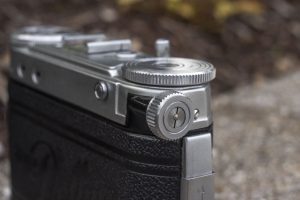
On the camera’s right side is one of it’s most interesting features, the focusing knob. As was the case with the original Dollina, focus is controlled by moving the entire shutter and lens standard back and forth. This is unlike the Retina which uses a focusing helix in the lens mount. The effect is the same, but this method was likely cheaper to produce as it doesn’t require the precision machining required for a helix. I don’t know if it’s a result of the design, or if there was another reason, but the Certo has a minimum 4 foot focusing distance which is uncommon for a 35mm rangefinder.
Focusing the camera does take some getting used to as it’s location is not where you’d typically hold the camera while shooting, but you get used to it quickly. The shutter release is within easy reach of your right index finger immediately after finding focus when you are ready to shoot.
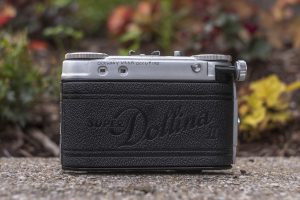
Perhaps taking another cue from the Retina, the back of the Super Dollina II has a large script logo prominently in the center of the door. This logo is quite elegant and something I wish other companies did as it breaks up the monotony of many cameras that simply have a large swath of body covering on the door.
On the left of the back of the top plate are the openings for the separate viewfinder and rangefinder windows. This is one of the biggest shortfalls of this camera and is a feature that likely meant it was never a serious competitor to Retinas of the same era. Although both the viewfinder and rangefinder windows do their job, the opening is very small. Tiny viewfinder openings like these were barely acceptable in 1935 when the first Dollina was released, but by the 1950s when this camera was on sale, was likely seen as a major con of the camera.
On the right side of the top plate to the left of the focusing knob is a sliding catch that I’m not entirely sure what it does as it does not appear in the camera’s user manual. I checked my example and sliding it back and forth seems to have no function. I can rewind film at the end of the roll without touching it and it does not appear to have anything to do with cocking the shutter or resetting the exposure counter. I asked my friend Mike Novak who is another collector with this same camera and he says on his that you cannot manually arm the shutter without sliding the button which leads me to believe this was either a mid model change, or mine’s broken. I am going to guess it’s the latter.
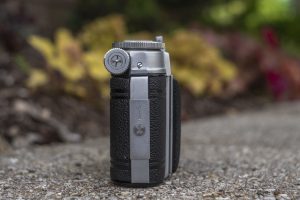
When it was time to load film into the camera, the back of the camera is opened by releasing the sliding door lock on the camera’s right side. The image to the right also gives another look at the focusing knob.
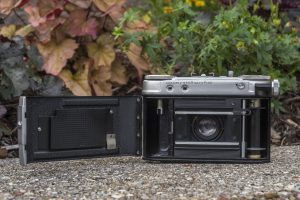
The left hinged door reveals a mostly ordinary film compartment with a couple unique details. Film transports from left to right onto a fixed take up spool.
While loading film into the Certo, there is a small metal plate that partially covers the sprocketed shaft to the right of the film gate. You must make sure your film loads in under this plate so that the perforations in the film correctly pass over the sprockets. Closing the rear door without making sure the film is correctly passing through this area can damage your film.
Another minor detail is a spring loaded metal bar on the right side of the compartment where the 35mm cassette loads to help keep it in position. While loading in a new cassette, you can feel it putting a small amount of tension on the cassette, likely keeping it from jiggling around while in the camera. I don’t know how necessary this is, but I thought it was a cool little detail that I’ve never seen in another camera.
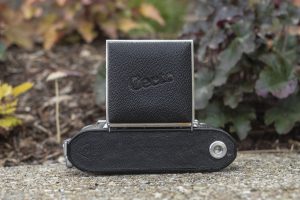
The bottom of the camera is almost all body covering with an offset 1/4″ tripod socket to one side. I would have preferred a centrally location for the tripod socket, but the design of the folding door would have interfered with a tripod had it been in the center. Although it’s not centered, the compact size and weight of the camera likely would have not caused problems with an offset mount like this.
Like other 1930s cameras, the viewfinder and rangefinder are separated and on mine, the rangefinder was non functional so the only thing I could possibly show you is the main viewfinder which is so small that I couldn’t even get a picture of it with my smartphone. Just trust me on this, it’s small.
The Certo Super Dollina II has some strengths and some weaknesses, but like any camera, most of that can be forgiven if the images it makes are good, but are they?
My Results
My first attempt at shooting the Super Dollina II came near the end of last summer and I was quickly dismayed at my inability to advance the film. It would seem that between the time I had been playing with it earlier, it had developed a defect and it stopped advancing the film.
Then I read the manual and realized I was doing it wrong. Doh!
My second attempt at shooting the Super Dollina II came after the first, and this time I used fresh Fuji 200 and quickly shot it around where I live before I would have a chance to forget how to use it again!
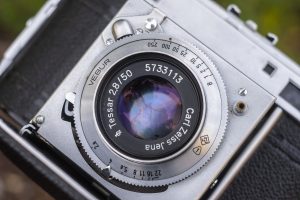
The name on the camera might say Certo, but the name on the lens says Tessar, and like all Zeiss Tessars, the images produced by the Super Dollina II were superb. The only imperfection in these images was a persistent light leak in the corner of many images and the fact that I missed focus a couple of times since the rangefinder wasn’t working and I had to guess focus for the whole roll. Otherwise these images look as sharp and detailed as those you’d get from a million other cameras using a Tessar lens.
The majority of what I can tell you in regards to using the Super Dollina II is in it’s design. I mentioned it earlier in this review, but it bears repeating that the viewfinder is very small. When used with prescription glasses, you cannot see the entire 50mm frame looking through it. For my test roll, I composed my images using just the center and didn’t try to tightly frame anything. This being a camera I was shooting for the purposes of a review, it didn’t bother me much, but there is no way I would ever try to use this camera to make meaningful photography, and I have a hard time believing that given so many other technically superior cameras at the time, many other people did either.
Of course there aren’t many times where I’d want to make meaningful photographs with a 65 year old folding camera, but it’s disappointing that this was considered “good enough” at a time when most other companies were embracing larger viewfinders. Maybe one day I’ll try shooting this camera again with an auxiliary viewfinder, but attaching anything to the camera would then negate it’s one greatest feature which is it’s portability.
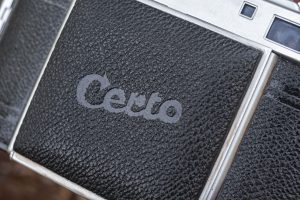
The Certo is very compact and with it’s rounded edges, easily slides in and out of a pocket. In that regard, it compares very favorably to a Kodak Retina with a different interface. The side mounted focus knob was different, but not difficult. I didn’t mind the film advance knob, but would have preferred an automatically cocking shutter as accidentally pressing the shutter release without cocking the shutter first, re-activates the double exposure prevention, requiring you to advance the film again before you can press the shutter button again. Alternatively, to avoid wasting an exposure, you can use your finger to manually fire the shutter using the small tab near the 8 o’clock position around the shutter, but this is awkward.
It might seem like I didn’t like the Certo Super Dollina II and that’s not entirely true. I’m disappointed that Certo didn’t put more effort into this camera and keep it more competitive to what other companies were releasing at the time, but I also think that can be explained by the socialist government whose priority wasn’t innovation. I doubt Certo had the resources to improve the camera even if they wanted to.
Still, the Super Dollina II is a well built camera that despite it’s limitations can still be used to produce excellent photographs. If for some reason you think a 1950s Kodak Retina is too modern for your tastes, this could possibly be the answer to your prayers!
Related Posts You Might Enjoy
External Links
http://camera-wiki.org/wiki/Dollina
https://www.dresdner-kameras.de/andere_baureihen/andere_baureihen.html#Certo
http://www.xylocopal.com/cc/super-dollina2.html (in Japanese)
http://thecameracollection.blogspot.com/2010/10/certo-super-dollina-ii.html
https://www.flickr.com/photos/greyscale3/sets/72157713782015622/

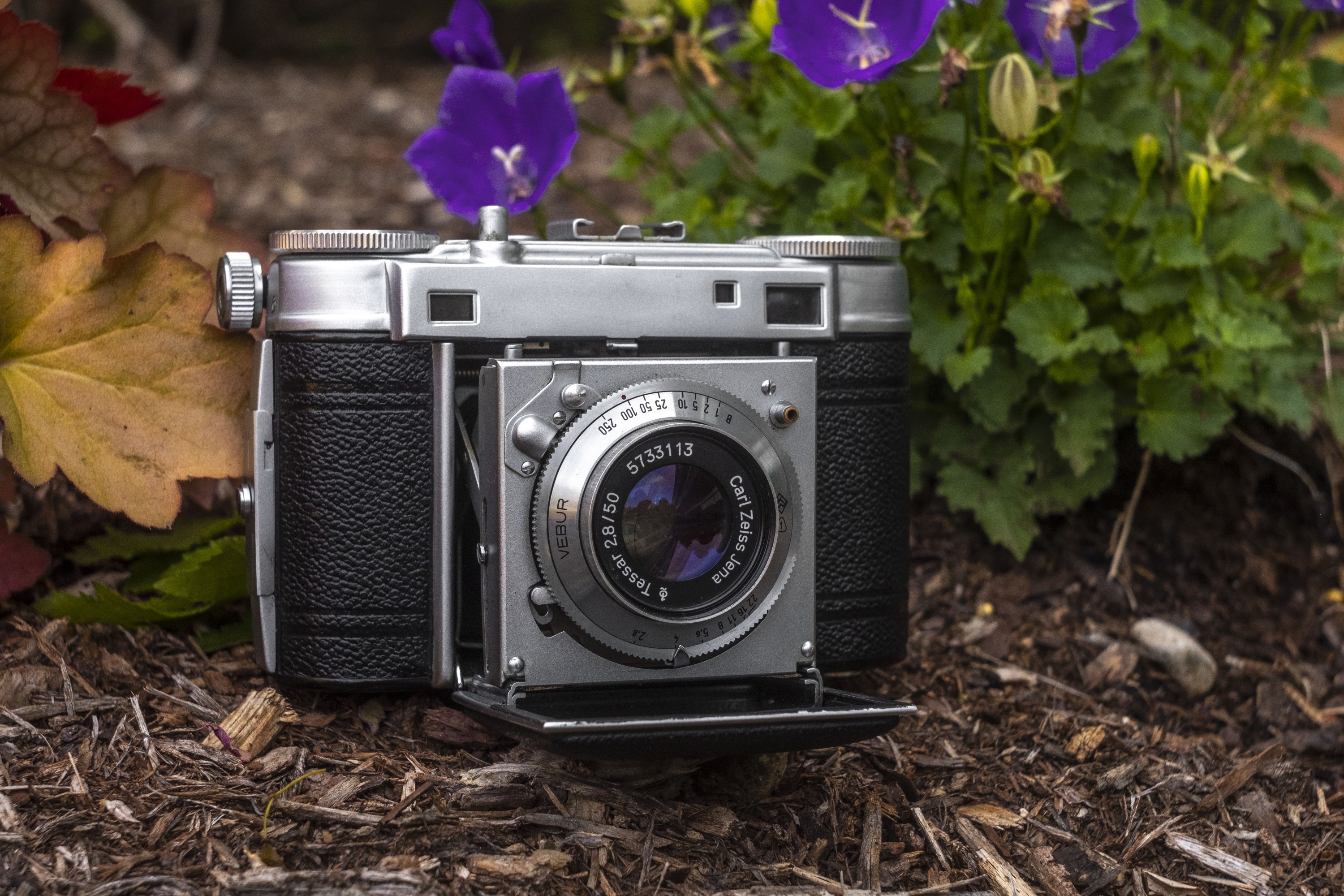
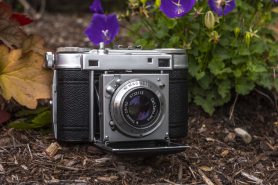
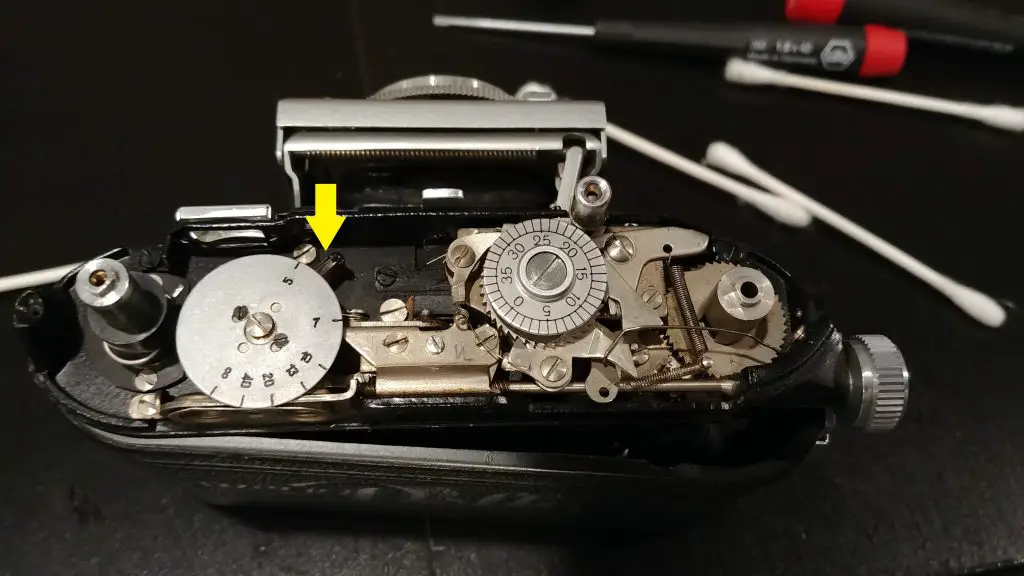
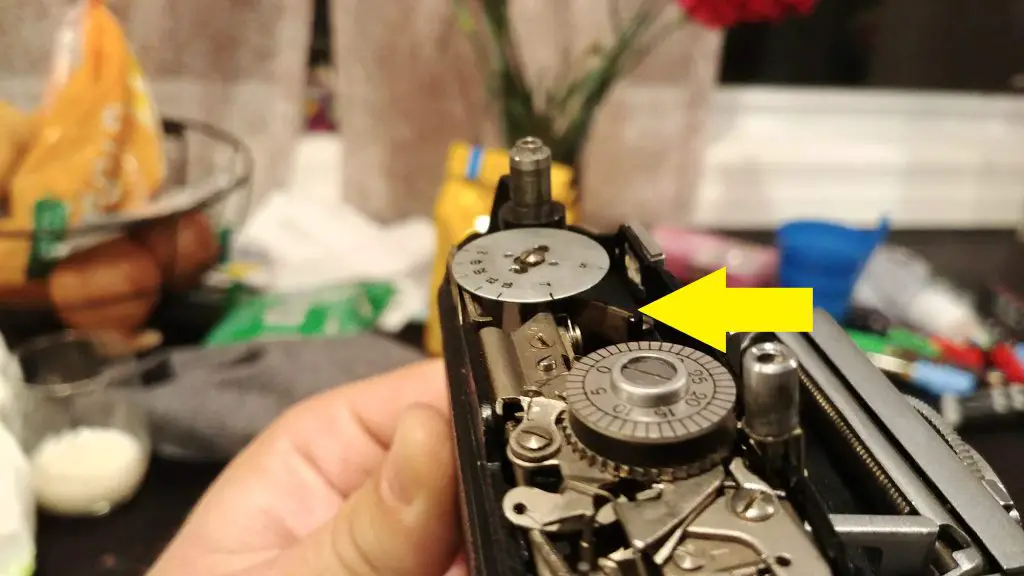
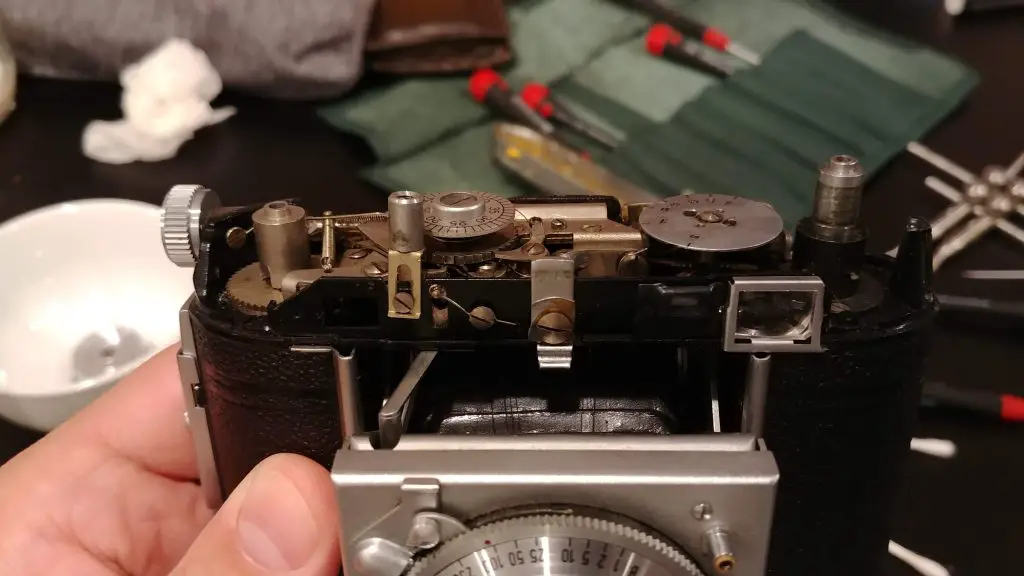












A good introduction to an offbeat camera – in many ways the Super Dollinas remind me of the Agfa Karat 35: Nice overall design but with a couple of serious drawbacks that interfere with ease of use. In the case of the Karat, it’s the film advance lever, which operates front-to-back similar to an Alpa SLR. Don’t plan to shoot several frames in rapid succession, unless you like hitting yourself in the forehead!
Mike: Is the Certo Super 35 the same camera as the one you’ve reviewed, maybe with a different name for the US market? Thanks!
Yep! I briefly talk about the US market Certo Super 35 in the article.
Oops – I see you already answered that question in your article. Sorry!
Awesome review! I have the same camera as you have here, and while the aperture adjustment knob does move freely, the aperture blades inside the lens seem messed up. Best description would be the blades are fixed in place “half open” and rotate with the adjustment knob. Can you see any way that the lens could be removed and the blades fixed so that the camera could be useful again, or is it junk?